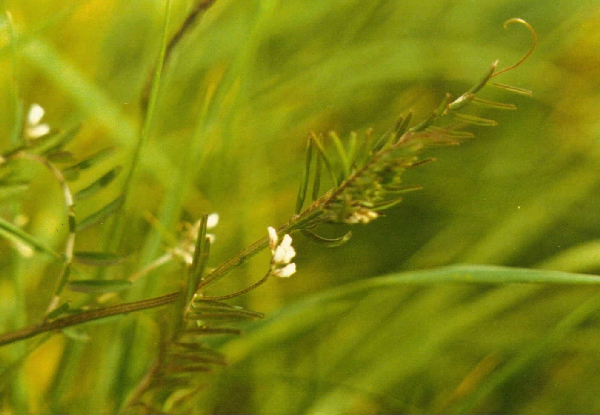
Alderney Nature Diary
June 2001
The Weather
With 10 days with over 15 hours sunshine, and only 1 day with very little, this June scored the highest number of hours since 1954, beating the previous record by almost 8 hours and the 20-year average by more than 80 hours. Total sunshine for the first 6 months was 173 hours above average.
Rainfall, with most of it falling on only 4 days, was barely half that of last year and not much more than a quarter of the average for June, but the 6 month totals were almost 100mm more than last year and 72mm above average.
Readings for pressure, temperature, humidity and wind speed did not differ significantly from last year although the maximum temperature reached was 2.6º below last year and the lowest recorded for the month 2.4º lower.
Wind direction averaged from the SW, slightly more westerly than in 2000, but was very variable round the compass on a number of days and alternated between northerly and southerly every few days.
Figures for comparison with June last year and the 20 year average
| Year | 2001 | 2000 | 20-year average |
| 1981-2000 | |||
| Rain mm. | 12.9 | 24.8 | 43.7 |
| Sun hrs. | 309.1 | 234 | 231.1 |
| Max. temp recorded °C | 23.9 | 26.5 | 21.5 |
| Min. temp recorded | 5.6 | 8.0 | 8.3 |
| Mean day temp | 16.6 | 16.4 | 16.7 |
| Mean night temp | 14.0 | 14.4 | 11.7 |
| Total rainfall, year to date, mm. | 403.8 | 333.9 | 320.5 |
| Total sunshine, year to date, hrs. | 984.7 | 886.3 | 915.9 |
The Diary
1st. June. Wall, Blue and Small White butterflies frequent in several places. A Mallard duck and three ducklings about a week old in the road by Robin Rock. Hairy Tare Vicia hirsuta, (photo on right) now flowering in many hedges and banks,

with the Common and "Narrow-leaved Vetches. A single large plant of Weld Reseda luteola (photo on left below), in flower amongst a number of Broad-leaved and Curled Docks Rumex obtusifolius and R. crispus at the roadside by the car park at Corblets Bay.
.
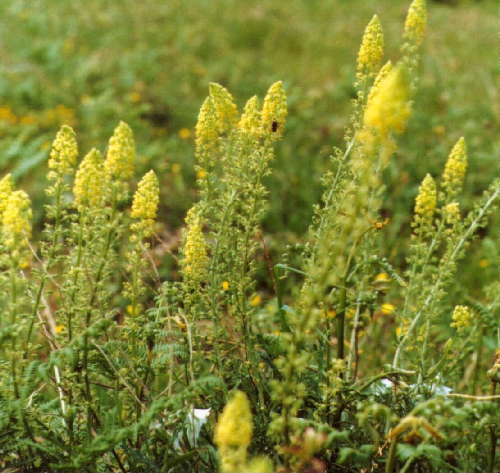
Nearby, the single plant of Burnet Rose R
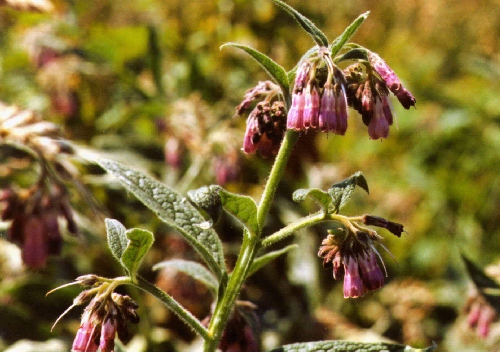 osa pimpinellifolia, first noted about 3 years ago and having suffered from verge mowing each year since, was just putting out new growth between the stones, near the bottom of the dry stone wall surrounding the grounds of the fort. Perhaps it will survive to flower this year. Giant Echium Echium pininana (photo on left below), spikes growing to 3-4m high over the last few weeks is now in flower in gardens and several odd "wild" spots all round the island. Russian Comfrey Symphytum x uplandicum (photo on right), is flowering in several fields and on hedgebanks and verges.
osa pimpinellifolia, first noted about 3 years ago and having suffered from verge mowing each year since, was just putting out new growth between the stones, near the bottom of the dry stone wall surrounding the grounds of the fort. Perhaps it will survive to flower this year. Giant Echium Echium pininana (photo on left below), spikes growing to 3-4m high over the last few weeks is now in flower in gardens and several odd "wild" spots all round the island. Russian Comfrey Symphytum x uplandicum (photo on right), is flowering in several fields and on hedgebanks and verges.
4th June. First Californian Poppies Eschscholtzia californica, of the year noted on a bank in Bluestone Hill.
5th June. Biting Stonecrop Sedum acre, together with Thrift Armeria maritima, and Eastern Gladiolus Gladiolus communis (picture in May diary), Bird's-foot-trefoil Lotus corniculatus and Valerian Centranthus ruber, in flower at the Arsenal and along the east c
 oast. On Braye Common a large area of Pale Flax Linum bienne, in flower in the shorter grass where the old steam driven stone crusher used to stand in the 19th century.
oast. On Braye Common a large area of Pale Flax Linum bienne, in flower in the shorter grass where the old steam driven stone crusher used to stand in the 19th century.
On Longis Common I noticed a huge, low-domed, spread of Wild Privet Ligustrum vulgare, just behind the German sea wall near the central gun emplacement. I can't remember recording this before, although Wild Privet is not very common on Alderney, but it must have been there for years. A large area of the common was pinky-brown with a forest of Red Fescue grass Festuca rubra. About 100 Starlings were congregated down by the Lighthouse. These seem much less common than usual this year.
12th June. The Wall Campanulas, Campanula portenschlagiana and C. poscharskyana the former with a funnel-shaped corolla and the latter with a star-shaped flower, are just opening on many old walls in Town and also in some garden rockeries.
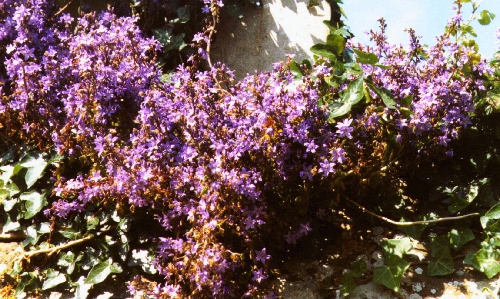

< Campanula portenschlagiana
.............Campanula ..........poscharskyana > .
.
.
.
The track leading down to the Impôt quarry was also bright with mauve Viper's Buglos and Sheep's-bit Jasione montana, yellow Bird's-foot-trefoil Lotus corniculatus, Hop and Lesser Trefoils Trifolium campestre & T. dubium, Sea Radish Raphanus raphanistrum subsp. maritimus and Cat's-ear Hypochoeris radicata, the white of Ox-eye Daisies Leucanthemum vulgare, Sweet Alison Lobularia maritima, Cow Parsley Anthriscus sylvestris and several rather stunted bushes of Elder Sambucus nigra, with many species of grass and docks also flowering. Amongst these were the lovely pink heads of the first Pyramidal Orchids Anacamptis pyramidalis, I had seen this year. An hour or so later, more of these were noted along the roadside verges at Longis and Braye and scattered in the longer grass at both places. (By the end of the month many were noted in other places too, including the southern cliff path. It seems to be a very good year for this splendid little orchid). Large areas of Pink Campion were flowering all the way down the cliff side between the gate and the quarry, with a few plants of Tree Mallow Lavatera arborea and many plants of both Common Mallow Malva sylvestris, Spear, Creeping and Slender Thistles Cirsium vulgare, C. arvense and Carduus tenuiflorus on the bank above the roadway, adding to the pink and pinky-mauve carpet of colour here.
On Crabby beach there was a mass of Viper's Buglos Echium vulgare, in flower at one end. The Sea Kale Crambe maritima, now stretches along most of the edge of the coarse shingle, just above HWM and there are several plants of Silver Ragwort Senecio cineraria, and a couple of Hoary Mustard Hirschfeldia incana, clumps flowering amongst them. Large patches of Sea Holly Eryngium maritimum, Sea Sandwort Honkenya peploides, Sea Bindweed Calystegia soldanella, Creeping Cinquefoil Potentilla reptans, Restharrow Ononis repens, and various Docks, including Fiddle Dock Rumex pulcher. The Bithynian Vetch along the top of the low cliff round the bay, mentioned in the May Diary, has now finished flowering and is in fruit, but I noticed for the first time that it has spread down the bank almost to the beach about 20-30m south of the main colony.
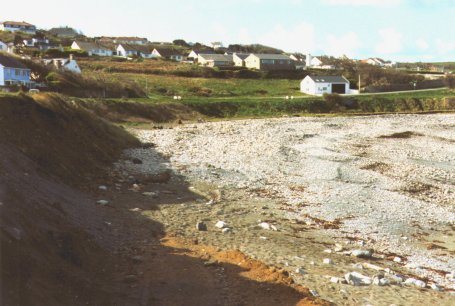
Crabby Beach
Platte Saline was showing many more species in flower. Hoary Mustard, (a Mediterranean species uncommon in UK, but found in sandy areas in Alderney in considerable quantity), two plants of Fragrant Evening-primrose Oenothera stricta, with another in the cobbled gutter in Le Petit Val a few yards away. A small number of Common Poppy Papaver rhoeas, in the barer areas. Large numbers of (mainly small) plants of Hare's-tail Lagurus ovatus, in the bare ground recently bulldozed flat near the German walls at the western end, with more scattered in the grass all across the common area and Great Quaking-grass Briza maxima, here and there, especially on the raised banks near Fort Platte Saline. The line of the Ladysmith stream running into the artificial pond from its
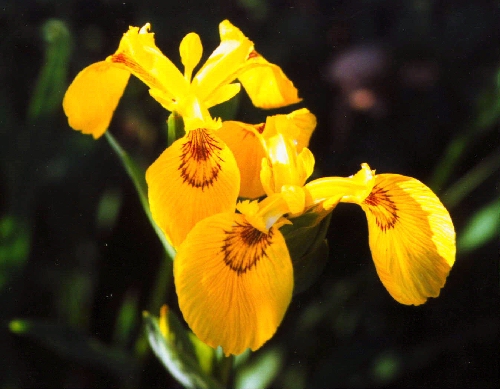
culvert under the road and houses opposite was bright with Yellow Flag Iris pseudacorus (photo above), spread greatly from a single planted clump, with several large patches of it beside the natural pond at the western end, fed by the Bonne Terre stream. At both these places Umbrella Sedge Cyperus alternifolius, has established itself and spread from some small pieces planted about 6 years ago. This native of Madagascar is occasionally grown as a house plant, standing in a dish of water, but, in our mild climate, reaches a metre or more in height outside and does well in garden ponds where it often seeds itself vigorously in the surrounding lawns. It also reproduces by viviparous plantlets formed amongst the circle of long narrow leaves produced at the top of the naked stem. These can be cut off and put into a pot where the soil is kept wet. The three large patches of Galingale Cyperus longus, in this pond have also spread, but much of the shallow open water has been colonised, whilst it was more or less dried up last summer, by Broad-leaved Docks, Amphibious Bistort Persicaria amphibia, Creeping Bent-grass Agostis stolonifera, Spear and Creeping Thistles, Nettles and Great Willowherb Epilobium hirsutum. A few plants of Greater Spearwort Ranunculus lingua, were about to flower amongst this thicker vegetation. The bank of the sandy track on the seaward side of the pond held many plants of Hoary Mustard, Hogweeed and a few Ox-eye Daisies, Slender Thistle and Hedge Mustard Sisymbrium officinale.
On the dryish area behind the dunes here, just east of the Vallée stream, 20-30 or more plants of Silver Ragwort are now well established, with plenty of Bird's-foot-trefoil, Rough, Knotted, Red & White Clovers, Common Broomrape Orobanche minor and Restharrow in the short turf around them. 3 or 4 Pyramidal Orchids were flowering close to the wall of the first bungalow This area used to be well endowed with them, but the occasional flooding of the stream through blockage by the roots of the rapidly expanding area of Great Willowherb, has considerably reduced the dry area favoured by the orchids. There is a small area of 2-3 dozen plants of the furry Mouse-ear Hawkweed Pilosella officinarum and hundreds of the tiny reddened plants of Sea Fern-grass Catapodium marinum.
On the dunes in front of the houses here, now built up to above the top of the German sea wall and permanently established, at a level now some 2-3m higher than that of the beach level below the wall 20 years ago, stabilised by considerable colonies of Sea Holly, Sea Bindweed, Sand Couch Elytrigia juncea, Hottentot or Kaffir Fig Carpobrotus edulis, both yellow and pink/puce forms and Rock Samphire Crithmum maritimum. Smaller areas of Sea Sandwort, Sea Spurge Euphorbia paralias, Sea Kale, Sea Beet, Sea Carrot, Sea Radish with some white flowered specimens, a little Cow Parsley, Silver Ragwort, seedlings of Yellow Horned-poppy Glaucium flavum, with a few plants already in flower, Common and Purple Broomrape, Yarrow Achillea millefolium, Cinquefoils Potentilla spp., many grasses, various yellow Asteraceae family 'daisies', Docks, Kidney Vetch (Lady's Fingers) Anthyllis vulneraria, Bird's-foot-trefoil and other smaller vetch and clover species were noted, plus a variety of small numbers of plants of various 'garden escapes' from the houses opposite, mostly annuals or biennials, which rarely survive for more than a couple of years. The Sea Kale and Docks in particular were supporting large numbers of the Mediterranean Sandhill Snail Theba pissana.
At Braye the first mauve/pink flowers on the patches of our only colony of Rough Star-thistle Centaurea aspera, were just opening. This site was saved from development as part of the extension to the Golf Course a couple of years ago and the patches seem to have spread somewhat over the last five years or so, but are still all within about a 40-50m radius. Vetches were now abundant, both the more frequent Narrow-leaved Vetch Vicia sativa subsp. nigra its single coloured pink/purple flowers and the seed pods from which are black when ripe with dark brown seeds and the less frequent Common Vetch with 2 shaded flowers V. sat. subsp. segetalis. Hairy Tare Vicia hirsuta with its delicate straggling stems and fine leaves, was now bearing the tiny off-white flowers and 2-seeded pods, growing through long grass, brambles and other vegetation in many places. Many plants of Fennel Foeniculum vulgare, are now forming their pale green flower heads, none yet open and making the large patches of bright yellow seen here and in many other sites in a week or two. Sea Radish however is now setting seed and the amount of yellow, or less frequently white, flowers much reduced. Cut-leaved Geranium Geranium dissectum and the pink, turning white, heads of Sea Carrot Daucus carotus subsp. maritimus, are now in flower here and in many other places. Sea Beet is in seed all along the top of the low cliff above the beach.
The grassy triangle between Battery Quarry and the Lower Road now carries a mass of many of these plants, but the Pyramidal Orchids, formerly found in their hundreds on this area now seem to be reduced to a few dozen after mowing at the wrong times in the last 4-5 years. On the other hand, Wall Barley Hordeum murinum, not a very common sight a few years ago, is now to be seen in considerable quantity along most verges and mown banks and grassy patches, presumably spread by the mowers.
Small patches of Stinking Iris
 Iris foetidissima (photo on right), were noted with their fairly inconspicuous pale mauve/brown flowers were noted on roadside banks in La Vallée, Longis Road, near Sharpe's Farm and around Mannez Quarry, as well as in the many damper spots where one usually expects to find them. Either side of the short grassy track up to the entrance to the Catholic Cemetery, suckering Hornbeam Carpinus betulus, trees were noted, the main, more easterly one, being quite a large specimen. As the only others I have ever noticed were planted in the Parish Churchyard many years ago, it seems likely that these too were planted at some time in the last 20-30 years. Nearby several planted Silver Birches Betula pendula, were just coming into catkin.
Iris foetidissima (photo on right), were noted with their fairly inconspicuous pale mauve/brown flowers were noted on roadside banks in La Vallée, Longis Road, near Sharpe's Farm and around Mannez Quarry, as well as in the many damper spots where one usually expects to find them. Either side of the short grassy track up to the entrance to the Catholic Cemetery, suckering Hornbeam Carpinus betulus, trees were noted, the main, more easterly one, being quite a large specimen. As the only others I have ever noticed were planted in the Parish Churchyard many years ago, it seems likely that these too were planted at some time in the last 20-30 years. Nearby several planted Silver Birches Betula pendula, were just coming into catkin.
Altogether an interesting day's observations.
Amongst all the many flowers detailed above, large numbers of Butterflies have been seen this month all over the island. Several people have commented on their numbers this year. The number of species recorded is only the usual ones expected, but the quantity of each suggests a good year for these too.
Emperor Dragonflies Anax imperator, also seem plentiful, many pairs being seen, patrolling over ponds and pools, occasionally touching in mid air with an audible clash of their wings and the females soon after depositing eggs on vegetation stems just below the surface. One or two Damselflies have been seen, but in no quantity as yet.
16th June. Honeysuckle (Lonicera periclymenum), Large Bindweed (Calystegia sylvatica), Field Convolvulus (Convolvulus arvensis), and many others flowering. A new site for Ivy Broomrape (Orobanche hederae), was noted in the car park at Le Cocq's Stores just off Marais Square. This is still within the line of the former Marais stream which goes under the Island Hall and down La Vallée, and keeps to the only known sites of this plant in Alderney, all along the line of this stream. Two well grown (planted long ago) specimens of Tree of Heaven (Ailanthus altissimus), were also in this same place.
22nd June.
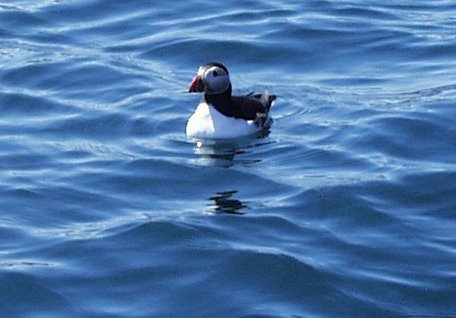
Made a trip round the island as guide in the MV Voyager. The most interesting find was seven adult Atlantic Grey Seals basking on a rock at the back of the Renonquet Reef beyond Burhou. Puffins, (photo above) were in good evidence, about 40 at the back of Burhou, 100 or more on the front of the islet and another 20-25 in front of the cliffs at Hannaine Bay, two or three more could be seen guarding the entrance to their burrows on the grassy slopes above, together with a number of Fulmars nesting. As well as the hundreds (?c. 1,000) of Gannet nests on Ortac, a few of them still with fluffy barely fledged chicks, there were about a dozen Guillemots noted on the lower ledges.
23rd June. Many Rough Poppy (Papaver hybridum) plants, several bushes of Hedge Fuchsia (Fuchsia magellanica) and Stinking Iris (Iris foetidissima) in Val Fontaine. Privet (Ligustrum vulgare) and the first Lucerne (Medicago sativa) of the season were just coming into flower in the Longis Road near the Golf Clubhouse, with the several bushes of Helichrysum (H. petiolare), in the scrub at the side of the course a few hundred metres further on also showing their 'dirty' yellow flower heads.
The land is bone dry everywhere with masses of Common Mallow (Malva sylvestris), and Wall Rocket (Diplotaxis muralis), in flower and many Pyramidal Orchids (Anacamptis pyramidalis), Eyebright (Euphrasia spp.) and Thyme (Thymus polytrichum), along Longis Common, either side of the road, with Carrot (Daucus carota ssp. gummifer) plentiful nearer the Lighthouse. The white-flowered Brambles and Elder (Sambucus nigra) were now well in flower all over the island with, as usual, a few scattered plants of Knapweed (Centaurea nigra), on the track leading up to the 'Odeon' and some clumps of White Stonecrop (Sedum album), and huge spikes of Navelwort (Umbilicus rupestris), up to 60cm high in the rough scree alongside the track. Sea Beet was now in seed with Hogweed and Cow Parsley still flowering and clumps of Blue Gem Veronicas (Hebe x franciscana), flowering so strongly that their leaves are almost obscured, in many gardens and a few odd roadside patches. Fresh flowers were noted on several patches of Eastern Gladiolus (G. communis) and Red-hot Poker (Kniphofia spp.). Spear Thistle (Cirsium vulgare) was just coming into flower everywhere and unusually frequent plants of White Campion (Silene latifolia), were noted in addition to the very common Pink and less common Red Campions. The white form is rare in Guernsey and uncommon in the other islands. A quantity of very dark-flowered Viper's Buglos by the Lighthouse wall and considerable numbers of Common Broomrape (Orobanche minor) plants, on the barish ground behind Corblets beach with the mass of Bird's-foot Trefoil and Ladies Fingers (Anthyllis vulneraria), this latter plant is also infrequent in Guernsey and Jersey and seems to be absent from Sark and Herm.
After nearly 15 years since it was almost emptied in the drought of 1986/7, the water level in Corblets Quarry has at last reached well above the windowsills of the old weighbridge hut. The field near Château à L'Etoc has been mown for the second time in a few weeks and there is again this year no sign of the Bee Orchids (Ophrys apifera) in their old habitat. Plenty of young plants of Radish, both white and yellow forms, Fiddle Dock (Rumex pulcher), Ladies Bedstraw (Galium verum), Spear Thistle, Smooth Sow-thistle (Sonchus oleraceus), Creeping Soft-grass (Holcus mollis ), Stinking Iris, Ragwort, Common Broomrape and a few plants of Purple Broomrape, etc. were sprouting up again in the mown area. Some white flowered Campion plants here appeared to be the white-flowered form of the Pink Campion, seen occasionally these have a different 'jizz' which is hard to describe. Considerable numbers of Wall and Blue Butterflies were about here. A new record round the edges of the area was a couple of dozen plants of Field Geranium (G. pratense), generally a fairly uncommon sight in Alderney, as well as a few Pyramidal Orchids which had both escaped the mower.
24th June. Goats'-beard (Tragapogon pratensis), flowering on Platte Saline.
25th June. The Indian Horse-chestnut (Aesculus indica), in Royal Connaught Square just beginning to open its candles
26th June. Another trip round in Voyager revealed a huge raft of about 300 Puffins in front of Burhou, with another dozen or two at the back and at least six Seals around the reef beyond. The state of the tide meant they were not basking on the rocks, but kept surfacing, sometimes within about 20m of the boat.
27th June. Several plants of Purple Toadflax (Linaria purpurea) on the verge by the Catholic Cemetery. "Bird 2" our regular Chaffinch visitor has been about again the last two or three days, this time with female and young, both busy feeding the babies in the tress outside my study window. Phacelia (P. tanacetifolia), Borage and Purple Viper's-buglos (Echium plantagineum, with a few scatterred white-flowered specimens) all flowering in the field along the Grand Val near the Giant Horsetail. Probably sown this year to encourage the bees in the nearby hives. Black Spleenwort (Asplenium nigrum), Wall-rue (A. ruta-muraria) and tiny plants of Hart's-tongue Fern (Phyllitis scolopendrium), in the mortar on the wall nearer Judge Barbenson's fountain, still no sign of the Rusty-back Fern quite plentiful here many years ago.
A new pathway has been opened from Le Petit Val to Bonne Terre valley, along the old line of the leat carrying water from Ladysmith to the millstream dam. The first part, after crossing the stream, has Spear Thistle almost 2m high, then makes a well wooded tunnel with huge old Elder trees with trunks up to 1m across near the base, mixed with plenty of
old Hawthorn, Blackthorn and a few well grown Elm suckers up to 15-20cm in diameter. Along the banks beneath these, a dense growth of Pink Campion with leaf rosettes up to 50-60cm across, plenty of Prickly Sow-thistle (Sonchus asper), some over 2m tall, well above the top of my head. Beyond the trees the open area is backed by bracken/bramble/coarse grasses with a few isolated Elder and Hawthorn bushes. The old Mill leat now holds a dense growth of Water Figwort (Scrophularia auriculata) and more Prickly Sow-thistle, both up to more than 2m high. A big patch of Greater Bird's-foot-trefoil (Lotus pedunculatus), a few plants of Hedge Bindweed (Calystegia sepium), behind the dam wall, mixed with a quantity of Marsh Thistle (Cirsium palustre), also up to 2m, various grasses, Green-veined Dock (Rumex sanguineus), Common Fleabane (Pulicaria dysenterica), Ragged Robin, Creeping Forget-me-not (Myosotis secunda) and a big patch of Mind-your-own-business (Soleirolia soleirolii), on a big bare area where the cleared scrub was burnt. Still no sign of the Southern Marsh-orchids (Dactylorrhiza praetermissa) which used to be in this area although, as noted at the end of the May diary, a single specimen was found in grass at the edge of an area of Willow scrub just below the dam wall. (Photo in May diary).